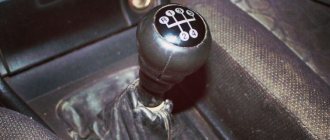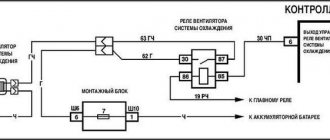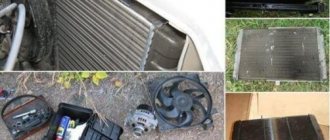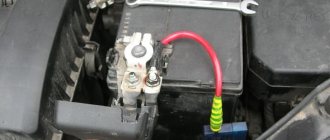During operation, the owners of the domestic Lada Kalina model identified a transmission flaw; reverse gear does not engage. There are several reasons that cause a malfunction of this nature. A modern car is stuffed with electronic devices, one of which can also serve as the initiator of this breakdown.
In our article we will try to touch in detail on the problem when the reverse gear in the transmission unit does not engage. Let's consider the reasons that cause this malfunction, as well as methods that allow you to independently find and eliminate the unpleasant defect.
Is there no way to engage reverse? What are the reasons?
- At the very beginning, you should not rush and frantically dismantle and disassemble such a complex unit as a gearbox if the reverse gear does not engage. You should take a closer look at the shift lever; perhaps the reason is hidden there. The link paired with the cardan in the switching mechanism are quite often the culprits of such a breakdown. There is no way to do without a viewing hole here.
- Among the probable reasons when the reverse speed does not work may be a failed release bearing. However, such a development of events would inevitably lead to the inability to normally engage any gear, and the process itself would be determined by the presence of crunches and difficulties.
- Also, when the reverse gear does not work, the reverse gear locking mechanism on the Lada Kalina may break down. To determine whether there is a malfunction, you will need to remove the shift lever handle and visually inspect this unit.
- There are frequent cases of damage to the wiring that is connected to the solenoids of the reverse stage locking unit. Let's talk about this moment next.
Related Issues
In some cases, the reverse still turns on, but there is no lamp. It is important to look at the overall plan here. If we are talking about one of the lamps, then most likely the problem is there. Although this is rare. If both lamps do not turn on, then you need to “ring” the circuit from the sensor to the lamps.
If only one of them does not light, then most likely the reverse lamp needs to be replaced.
This is done from the trunk. Remove the casing and unscrew the lamp socket (counterclockwise). Then you need to remove the lamp itself from the socket. Press and turn counterclockwise. Done, install the new lamp in reverse order.
tweet
back Characteristics of the on-board computer on the Lada Kalina and its replacement
Next How to fix the idle speed sensor on Kalina?
Tag sensor, reverse sensor, replacement
Dismantling and repairing the locking mechanism
About theory.
The solenoid power circuit in the Lada Kalina car includes a switch ring located in the gear selector handle. The device operates as follows. By lifting the ring, the driver activates the power supply to the solenoid, which in turn causes the reverse speed control unit to unlock. Access to activating this transfer is now open. When the lever is moved to the required position, the limit switch located on the Lada Kalina transmission housing is activated. This allows you to activate the rear brake lights and an audible warning signal sent through the interior speaker.
Repair process
- If reverse gear is lost, the following procedure must be performed. By participating in the circuit of the fuse link “F21”, +12V power is sent to the winding of the solenoid “L1”. There is a switch “S1” in the handle, which closes the ground contact, which causes the solenoid coil to activate.
- The fuse we are interested in is located inside the mounting block and is installed in the eighth socket of the LADA Kalina, if you count from the left. The current strength for this insert is 10A. If suddenly the fuse turns out to be faulty, then replace it with a similar insert with the specified characteristics.
- Next, we check the switch itself. For this purpose, lift the handle cover and find the connector. It is connected directly to the switch. We carefully disconnect.
- We take a regular paper clip and use it to close the corresponding contacts in the connector.
- We make an attempt to engage reverse gear on the LADA Kalina, and when this action was successful, we conclude that the switch is unsuitable. If we fail, then we continue to diligently search for the source of the trouble.
- Remove the solenoid connector and insert two pins into its contact grooves. Now we call for help with a tester, which we use to measure the voltage. The display of the device should display the number 12 (naturally, Volts). We load this local circuit by connecting a light bulb. A 5-watt device will be sufficient. If the lamp refuses to light, then we are dealing with a break. The presence of voltage here can be explained by the presence of resistance resulting from the natural formation of copper oxide.
- In 99 percent of cases of wiring malfunction, expressed in fractures or breaks in the supply wires, the cause is the harness, which is located next to the clamp on the pallet.
- We dismantle this clamp by carefully squeezing its fastening elements.
- Disconnect the rear brake light switch connector. We take out the tourniquet. Remove the insulating tape from the corrugated shell and remove the wires. If there is a break, it can be easily detected.
- Using wire cutters, we pinch off the remains of the damaged wiring and install new wires, which we select with a similar cross-section. We recommend soldering the connecting node itself. Now let's isolate. Alternatively, you can use a new corrugation. Our goal is to prevent moisture penetration during operation.
- We fix the harness with a new plastic clamp.
- We connect the previously removed connectors and turn on the power to the solenoid.
- The presence of a malfunction within the solenoid itself is a rather rare case, but possible. To check, we use the same tester. We measure the resistance at the terminals. Its value should be 2.2 ohms. If it turns out that the solenoid is the culprit, replacing it will require draining the transmission oil. Some dodgers manage to do without draining. After dismantling, they, with a deft movement of their hands, plug the hole with a suitable gag, and before installation, they sharply remove it. A slight loss of oil will still occur, but these crumbs can be topped up without any problems.
- When installing the solenoid on the Lada Kalina, do not forget to lubricate the threaded part with sealing glue, otherwise after a while the oil will begin to treacherously ooze out of the box.
Lada Kalina reverse gear failures and how to fix them
There are quite a few reasons for the failure of the rear gear of the Lada Kalina. And it is not always easy to find out the origin of this breakdown. Reverse speed in cars that are equipped with a large number of electronics and sensors is generally not activated when problems arise specifically with the electronics.
Reverse gear does not engage: reasons
- Let's start setting up the car with the simplest thing. Before a global search for a breakdown, it is necessary to check the serviceability of the gear lever; it is probably the one that has failed. The cardan and rocker often break. Maybe the splines just “licked off”, or maybe the tension of the clamp has decreased. All these problems can only be removed from the inspection pit.
- If engaging the gears is difficult and they “crunch,” then the problem lies in the release bearing, but this is unlikely.
- Failure of the reverse gear can occur when the reverse locking mechanism fails. To confirm your assumption, you need to dismantle the gear shift lever together with the dashboard and inspect everything thoroughly.
Often the problem with reverse gear failure is the failure of the transmission lock solenoid wiring. It may break or break. You can fix this problem yourself.
Repair of the rear gear locking mechanism Lada Kalina
Current is supplied to the solenoid through the switch ring. It is located on the gear lever. When reverse gear is engaged, the ring rises and the solenoid is turned on, the rod is pulled into the solenoid and reverse gear operates. Then the limit switch located on the gearbox turns on, and the rear brake lights light up, accompanied by an intermittent beeping sound inside the car.
Materials and equipment for repairs
To fix a faulty Lada Kalina gear shift, you will need:
- Heat shrink or electrical tape.
- Car key for 36.
- A piece of copper wire.
- Tester for checking the presence of voltage.
- Soldering device.
The work on repairing the rear gear of the Lada Kalina takes place in several stages:
Solenoid control: diagram
On the Lada Kalina gearbox, the solenoid control circuit consists of the L1 solenoid itself, 10 A fuse F21, and switch S1. A current of 12 V is supplied to the solenoid through a fuse. Then the circuit is closed to ground at the gear lever and the solenoid coil begins to operate thanks to the switch. Fuse F21 is located in a special fuse block, it is the eighth on the left side. It must be removed and checked for functionality using a tester. If the fuse is faulty, you need to replace it with a new one.
If everything is in order with the fuse, you need to make sure that the switch is operational. It is located under the pen cover. It is necessary to pull out the connector from the switch and use a paper clip to close the contacts in the connector. You can try to put the car in reverse. If everything works, then the cause was a faulty switch. But the reverse gear may not engage, then you will have to look further for the reason.
Remove the connector from the solenoid and place two small pins in it. We measure the voltage using a tester. It should be 12 V. Also, to check, turn on a 5 W light bulb at 12 V. The absence of light indicates a break, and the voltage comes from the resistance formed by the oxide film.
Mostly, the harness fails at the point where the clamp is installed on the pallet. To eliminate this type of damage, you need to remove the clamp, disconnect the connector from the stop switch and remove the entire harness. You will see that the entire corrugation is wrapped with electrical tape. It must be removed and the wires pulled out. If the wires are broken, you will see it immediately.
The defective wires must be cut off with wire cutters and new ones of the same diameter must be connected and the cross-sectional size must also be the same. To ensure a reliable connection, the twisting area must be soldered. If the corrugation also does not inspire confidence in you, then it also needs to be replaced, otherwise the problem will soon arise again due to moisture ingress. The harness must be secured with a plastic clamp.
Other reasons
If all of the above manipulations did not lead to the expected result, and the reverse gear disappeared, then it remains to perform a few more testing techniques, namely:
- It is possible that a malfunction has occurred in the fastening mechanism of the gear selection unit. We check and fix it.
- The fixing bolt has received irreparable damage and does not perform its function. We change.
- The spring in the gearbox broke and the reverse gear disappeared.
As you can see, the reasons may be different, but the danger and trouble in these three situations is that it will inevitably be necessary to dismantle the transmission unit itself.
Changing the oil in the automatic transmission of Lada Granta
Oil filter Granta
Fuel consumption Lada Granta
Transmission
The first reason may be a malfunction in the gearbox itself. Malfunction or wear of components can lead to the speed being knocked out or not turning on.
The most “harsh” method and breakdown is breakdown of the gearbox itself
The first thing you need to pay attention to is gear oil. When it loses its chemical and physical properties, it changes viscosity, which can lead to gear jamming. Read more about choosing gearbox oil for Lada Kalina in this article.
The second reason may be the wear of the internal parts of the gearbox itself. In this case, you will need to dismantle the gearbox and disassemble it. The reason may be wear of the following parts: reverse gear, rear bearing, synchronizer or shift fork. To eliminate the malfunction, it is necessary to replace the part that was demolished.
Clutch
New clutch disc
Another reason why the gear does not engage is the failure of the clutch. This is easy to determine, because when the transmission is depressed, the gear does not engage or engages with a bang. So, it's worth looking at the release bearing or clutch disc. If the diagnostics shows high production, then it is necessary to replace the parts.











